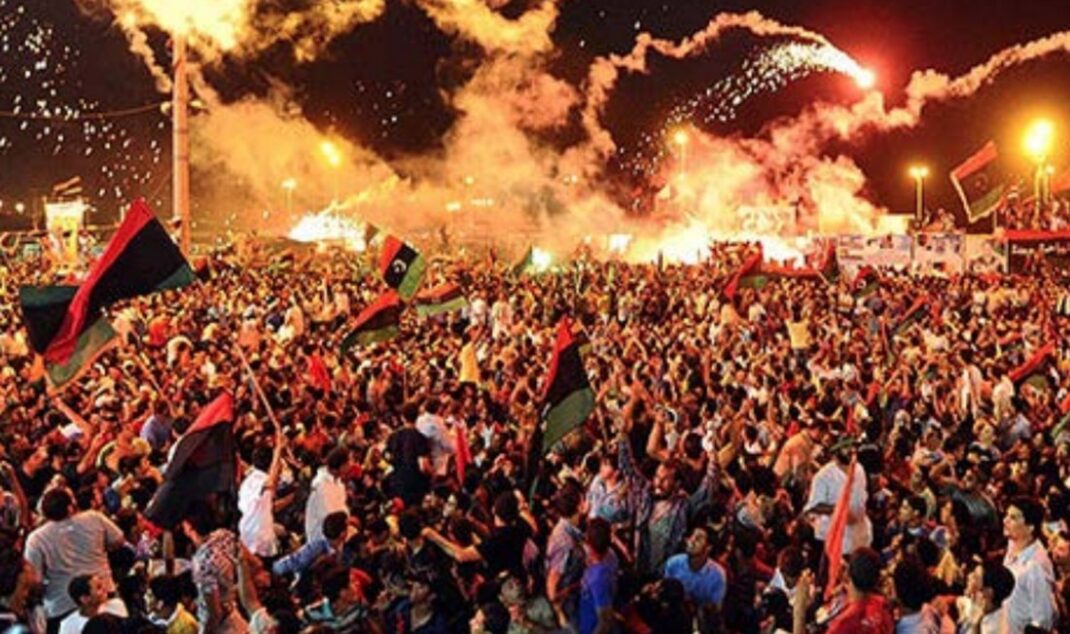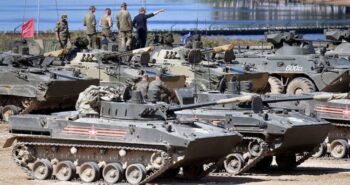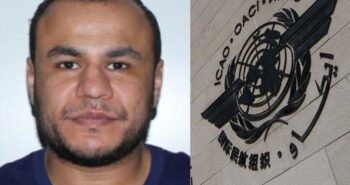Editors: Nadja Berghoff and Anas El-Gomati

 A decade on from the February 17th revolution, how the global disorder transformed Libya into a battleground for interest, ideology and influence.
A decade on from the February 17th revolution, how the global disorder transformed Libya into a battleground for interest, ideology and influence.
Chapter 9
Qatar: From Activism to Pragmatism
By Dr Andreas Krieg
 Qatar’s engagement in Libya over the past ten years has been all but coherent with it being one of the first Arab nations together with the United Arab Emirates (UAE) to support the NATO-led effort to first protect civilians and then topple the Gaddafi regime.
Qatar’s engagement in Libya over the past ten years has been all but coherent with it being one of the first Arab nations together with the United Arab Emirates (UAE) to support the NATO-led effort to first protect civilians and then topple the Gaddafi regime.
Overall, Qatar’s changing role in Libya has been guided by the same ideational vision of overcoming authoritarianism in the Arab world but has witnessed different strategies being used over the years to support this vision.
While between 2011 and 2014 Qatar played an active role shaping the conflict on the ground through direct support to a variety of nascent actors, Doha effectively withdrew from the conflict in 2014 to re-evaluate its strategy.
Qatar only returned to the conflict in 2020 to support the UN-backed process using ways and means that are profoundly more discreet from the means used in their earlier engagement in the first phases of the Libyan conflict.
Vision
Qatar’s readiness to aid the NATO-led effort to stop the Gaddafi regime from mass atrocities being committed against protestors, was inspired by the overall vision of the then Emir Hamad bin Khalifa al Thani (HbK) and his Foreign and Prime Minister Hamad bin Jassim al Thani (HbJ) to exploit the opportunity presented by the Arab Spring to reshape the socio-political outlook of the Arab world.
Libya unlike Syria or Yemen seemingly provided a considerably easier conflict to manage without meaningful sectarian fault lines and a promising wealth-to-capita ratio.
The protests that by early 2011 had spread widely across North Africa provided a mobilization unseen in the region since the beginnings of Arab nationalism and thereby a chance to overturn the authoritarian regimes that had undermined progress and development in the Arab world for decades – a chance Qatar’s Emir HbK and his Foreign Minister HbJ were willing to take.
On the one hand, Qatar’s engagement in Libya was guided by the same ideational vision that informed Qatar’s actions in other Arab Spring conflicts, most notably Syria, Tunisia and Egypt: replacing authoritarian and nepotistic regimes unable to cater for the needs and desires of its people, with more pluralistic and inclusive forms of governance.
The vision of Doha in 2011 revolved around the idea of socio-political pluralism to create a new Middle East where rulers are more accountable to their populace.
Qatar – an autocratic tribal monarchy itself – thereby repeatedly invoked narratives of ‘democratisation’ and ‘supporting the people’ in justifying their decision to engage in Libya and elsewhere.
This ideational vision was borne out of Qatar’s inexperience of acting unilaterally on the world stage and the resulting grandstrategic naivety over its ability of post-revolutionary state and nation-building in the region.
On the other hand, Qatar witnessed an opportunity during the Arab Spring to fully emerge from the shadows of Saudi dominance and carve out a geo-strategic position of its own right in the region. In so doing, Doha used the Arab Spring as a catalyst to move from the position of a regional mediator to a country taking and defending clear policy objectives – all with a view to also deepen relations with Western partners.
The fact that the United Kingdom and France were actively looking for Arab support for the NATO-led operation against the Gaddafi regime, suggested to Doha that it could use the opportunity to present itself as a constructive and committed Western partner able to assume some of the burden of regional conflict.
Strategic Ends
When British Chief of Defence Staff Sir Richards called his counterpart Hamad bin Ali Al Attiyah in Qatar in early March 2011 to ask whether Qatar was able to support the NATO operation on the ground, Qatar accepted the invitation.
Qatar’s government involving the Emir, the then Heir Apparent Tamim bin Hamad al Thani and the Foreign Minister HbJ, decided on a strategy for Libya in a fairly pragmatic manner.
The strategic end game from a Qatari point of view morphed quickly from merely supporting the opposition to overthrowing the regime in parallel with a mission creep developing within NATO’s strategic headquarters.
The idea in Doha was that upon the removal of the Gaddafi regime, an inclusive state and nation-building effort would allow for the reintegration of the various rebel forces into a security sector accountable to a civilian authority chosen by the Libyan people.
With only a relatively small military force, the Qatar Armed Forces required local partners on the ground that needed to be empowered and mobilized to first defend and push back against the Gaddafi regime.
In search for local partners, the Qatari leadership was looking close to home in Doha for Libyans who could provide inroads into the opposition that was mobilizing against the regime in Tripoli.
Doha, which at the time had already become a meeting place for the Arab diasporas from across the region, provided a range of networks that Qatar could exploit to build bridgeheads in Libya to support the NATO air operation from the ground.
The Libyan partners that were chosen by Qatar during the early stage of the operation were diverse, comprising all elements of the broad anti-Gaddafi front inside Libya and within Libya’s diaspora. However, as in other Arab Spring conflicts, the Islamist milieu appeared to be the best organized presenting a network of reach that far exceeded networks of other actors.
Nonetheless, reducing Qatar’s engagement merely to Islamists fails to appreciate the breadth and width with which Doha tried to tie in different actors into the revolutionary campaign.
Unlike Egypt, Libya lacked a coherent unified Islamist actor such as the Muslim Brotherhood and many of the actors Qatar engaged such as the politically diverse National Transitional Council’s leadership to the local factions in Misrata or Zintan would not identify themselves as Islamists.
It might therefore be more appropriate to speak about an Islamist milieu that was in its infant stage in 2011. Overall, Qatar’s approach to Libya was pragmatic within the context of its vision for reshaping the post revolution Arab world.
The selection of partners on the ground followed a rationale of operational effectiveness and not ideological alignment.
Allegations that Qatar was pursuing an Islamist agenda in Libya or elsewhere, are often politically motivated and do not account for strategic considerations in Doha at the time, which were all driven by the objective of finding local partners that could provide an effective lever of power Qatar could use to support NATO’s operation in pursuit of its own ideational and geo-strategic objectives.
Strategic Ways and Means
Qatar intended to use largely the information and military lever of power to implement its strategic objectives of empowering the opposition to overthrow the Gaddafi regime.
In a first instance, Qatar’s Al Jazeera network became an important force multiplier in the information environment providing a platform for all opposition groups to have their opinion heard. Al Jazeera’s slogan of providing “a voice to the voiceless” meant that the network’s Arabic channel primarily focused on civil societal platforms for the opposition groups to share and spread revolutionary narratives, directly targeting the regime and its inability to provide for the people.
Al Jazeera had been an enabler for the first movers in the revolution to build followership and mobilize wider parts of society showcasing the extent to which the regime was unfit to rule.
Much of Al Jazeera’s coverage thereby was preoccupied with the reasons for why the regime had to be removed and much less with proposing avenues for postrevolutionary state and nation-building.
The second lever of power that specifically in the first part of the revolution played a critical role for Qatar’s engagement on the ground was the military.
The Qatar Armed Force (QAF) set up a training and equip mission aimed at supplying the various rebel factions with material support against regime forces.
Further, QAF Special Forces were involved in training and directing rebel groups in their vital push on Tripoli – a contribution that NATO leaders and British Chief of Defence Staff Sir Richards called critical for the NATO operation, which was almost exclusively conducted from the air.
QAF Special Forces helped consolidate forces on the ground and provide operational support and direction that helped build a more coherent revolutionary force from the multitude of different rebel factions on the ground.
This surrogate warfare approach taken by both Qatar and the United Arab Emirates on the ground, promised to be short-sighted as it disregarded the dynamics of the armed groups environment where groups morphed, merged and arms were proliferated.
The inherent problem of the surrogate warfare approach was that it did not prove sustainable as surrogates continued to evade patron direction despite having received extensive funds and material support.
In hindsight, the surrogate approach taken by both Doha and Abu Dhabi and endorsed by NATO partners in the UK and France paved the way for the polarization of the post-revolutionary environment in late 2011.
Strategic Failure
After the death of Gaddafi in October 2011 the increasingly polarized postrevolutionary environment imposed a strategic challenge on Qatar that its government did not predict.
Instead of facing a unitary rebel movement happy to engage in inclusive dialogue over setting up a new governance structure after the fall of the regime, Qatar was confronted with a multipolar environment of competing political interests with groups promising to help implement Qatar’s vision of an inclusive state and nation-building effort.
By late 2011 actors on the ground had started to compete for external support from a variety of actors with armed groups appearing to the most potent powerbrokers in the country. Doha was lobbied by a variety of actors for their political, financial and material support in securing a postrevolutionary order.
By 2012 Qatar had increased its support to a variety of actors with a growing focus on existing networks in the Islamist milieu – something that would place Qatar on a confrontational course with some political elites emerging in Tripoli.
The belief in Doha that Islamist groups could be co-opted and appeased later on proved thereby at the heart of a strategic miscalculation.
Amid ongoing political consolidation first in the National Transitional Council and from 2012 in the General National Congress, Qatar continued to engage and support armed groups in the belief that they held the necessary leverage in the fight for the post-revolutionary order in Libya.
Qatar’s dual approach of supporting the political process while at the same time trying to secure inroads to the armed groups network undermined its ability to play the role of an honest broker that it was able to play in the first phase of the conflict.
It became apparent in 2013 that Qatar was hopelessly overstretched with desperate attempts to secure influence in Libya through ongoing channelling of funds and material support to competing actors claiming to fight on behalf of the “people’s cause”.
Re-Assessment
By late 2013 and early 2014 the new government under the new Emir Tamim bin Hamad al Thani had to concede strategic failure in Libya, as Qatar’s vision, ends, ways and means were no longer aligned. As part of the new Emir’s more domestic focus, Qatar withdrew its support from the Libyan theatre, disengaging from North Africa.
The costs of intervention in the Arab Spring both in terms of financial and reputational costs for Qatar were no longer aligned to the benefits they once hoped could be achieved through reshaping the regional order.
The experience of the military coup in Egypt following a year of Muslim Brotherhood rule starkly brought home the reality for Doha about the limits of the small state’s reach and strategic depth – especially when acting unilaterally.
As other actors and forces would go to dominate the post-revolutionary environment in North Africa, Qatar’s role in Libya effectively came to an end in 2014. Instead of trying to unilaterally shape the outcome of Arab Spring, Doha under the new Emir became ever more quietist, working through multilateral channels and supporting the UN-backed political process in Libya.
The reputational risks of strategic overstretch and allegations of having supported extremist groups between 2012 and 2014, meant that Qatar had to find other ways to play a more constructive role in the Libyan process. Thereby, Qatar’s vision for inclusive and pluralist governance in Libya legitimised by and accountable to the people remains unchanged.
Its strategic re-evaluation of 2014, however, meant that the means and ways to achieve its ends changed. Multilateralism replaced unilateralism and instead of supporting non-state actors, Doha engaged with internationally recognized government entities – more recently with the Government of National Accord (GNA).
Qatar has provided support for the UN-backed arms embargo and helped the GNA to receive more international recognition and legitimacy.
The fact that Qatar continued to engage with a leader such as former Prime Minister Serraj goes to show that Qatar’s engagement in Libya is far from ideological but shaped by pragmatism while placing great importance on the issue of international legitimacy.
In 2020, Qatar re-appeared as a more direct actor following the Libyan conflict.
Instead of merely supporting Turkey’s policy in Libya from behind the scenes, Qatar signed several agreements with the GNA to assist with security sector reform and the creation of state institutions following two lengthy civil wars in Libya since 2014.
In doing so, Qatar’s engagement is closely aligned with partners in Turkey, the United States and the European Union.
Conclusion
Qatar’s role in Libya has undergone an extensive learning process over the past decade. Premised on a wider ideational vision of liberalizing the political order in the Arab world, the emirate’s Libya strategy manifested the limitations of its strategic depth and reach, which led to the country’s reassessment of its engagement in Libya.
The lessons learned from Libya have allowed Qatar to play a more constructive role in the process following its withdrawal in 2014.
Multilateralism, international legitimacy and transparency make Qatar today a more reliable partner for the West when dealing with the various power brokers.
***
Dr Andreas Krieg is an assistant professor at King’s College London’s School of Security and fellow at the Institute of Middle Eastern Studies. He is the director of the London-based risk consultancy firm MENA analytica. Dr Krieg has worked on subthreshold and non-state violence in the Middle East for over 15 years and recently published the book “Surrogate Warfare” with Georgetown University Press.
Nadja Berghoff – Programs and Communication Fellow at Sadeq Institute.
Anas El-Gomati – Director, Libya’s 1st think tank. Chief contributor Security & Governance.
____________





